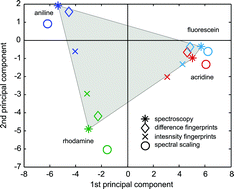Effect of fingerprint conformation and spectral scaling on the performance of computer screen photo-assisted experiments
Abstract
The use of computer screens as controlled light sources and web cameras as image detectors (the so-called computer screen photo-assisted technique, CSPT) is an ubiquitous alternative for the evaluation of colorimetric quick tests at homes or in primary care units. The performance of CSPT for such evaluations depends on several factors, from which the most relevant are the composition of illuminating sequences and the conformation of CSPT substance signatures. In this work, with the aid of a CSPT model, the effect of the construction of the substance signatures on the classification performance of different representative substance sets is studied. The correlation of illuminating colors with such classification is investigated, allowing one to determine redundancy and limitations with respect to


 Please wait while we load your content...
Please wait while we load your content...